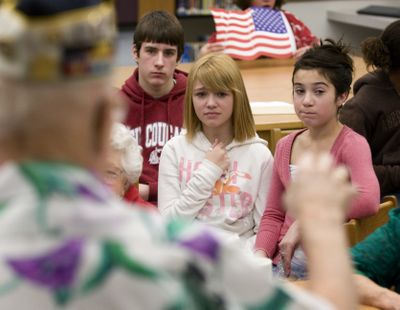Veteran storytellers

Hearing about the attack on Pearl Harbor from people who were there isn’t the same as watching a Hollywood version of the attack, students at Chase Middle School said Friday.
It’s better. It is, in fact, “awesome,” several seventh-graders said after listening to veterans Denis Mikkelsen, Sid Kennedy and Warren Schott, and Warren’s wife, Betty, who lived with him in military housing on Dec. 7, 1941.
Ken Wortley’s social studies students studied up on the attack that put the United States into World War II, reading articles about life on the military base and watching battle scenes from the 2001 movie “Pearl Harbor,” starring Ben Affleck and Josh Hartnett.
But the aviation pyrotechnics of the movie were far different from the eyewitness accounts of the survivors.
Kennedy, who was a 17-year-old sailor at the time, didn’t see the start of the attack because he was in the hospital at Kaneohe Naval Air Station. “I was in sick bay,” he explained, but was well enough to be pressed into duty to help the arriving wounded.
Mikkelsen, who was aboard the USS West Virginia, said he never did see a Japanese plane, although he had to abandon ship and swim to shore, where he saw the USS Arizona blow up.
Warren Schott saw a Japanese plane, from the window of his Ford Island fourplex after Betty woke him up to say something was burning down at the docks. By the time they got out to the street, sailors were coming up on the island covered with oil. The Schotts tore down their curtains to give the survivors something to wipe the oil from their face and eyes.
Were you afraid? one student asked Mikkelsen.
“Absolutely,” he replied. He was also confused, because he didn’t know the United States was close to war, but he ran to his battle station “and did what I was told.” He fought fires on his ship, but he didn’t fire a weapon that day.
Did you lose any close friends? asked another.
Not on the West Virginia, but a good friend died on the Arizona, he said.
The veterans gave short answers to how the war started and ended, and they answered every question except how Pearl Harbor got its name. But historian Carol Hipperson, who has written a book about the experiences of a Coeur d’Alene veteran of Pearl Harbor and accompanied the group to Chase, guessed that it was named by the native Hawaiians.
(Note to Mr. Wortley’s class: Hipperson is right. The native Hawaiian name translates as “pearl waters” because the bay was originally full of pearl-producing oysters.)
The veterans also explained how different life was in 1941 from life in 2008. The Schotts arrived in Hawaii before it was a state and before it developed into a tourist destination. For a while they lived a half-block from Waikiki Beach, learned to surf, and fished with the natives.
“We did not have communication quite like you kids are used to. There were no cell phones or computers … it took two weeks to send things by mail,” Betty Schott said. “It’s an entirely different world.”
“That’s because we’re over 90,” Warren Schott added with a smile.
Student Luba Shevchenko said she thought it was “pretty cool” to hear from the survivors, who are older than her grandparents. They gave her a clearer view of what it would’ve been like to be there. She and classmate Brittany Sorenson said the most interesting thing was trying to imagine being on a sinking ship, as Mikkelsen was.
Gabe Hernandez agreed that it was better hearing about the attack from survivors. “It was kind of phony the way the movie put it, compared to what it was.”